Matteo Pagin
Department of Information Engineering, University of Padova, Italy
Minimizing Energy Consumption for 5G NR Beam Management for RedCap Devices
Sep 26, 2023Abstract:In 5G New Radio (NR), beam management entails periodic and continuous transmission and reception of control signals in the form of synchronization signal blocks (SSBs), used to perform initial access and/or channel estimation. However, this procedure demands continuous energy consumption, which is particularly challenging to handle for low-cost, low-complexity, and battery-constrained devices, such as RedCap devices to support mid-market Internet of Things (IoT) use cases. In this context, this work aims at reducing the energy consumption during beam management for RedCap devices, while ensuring that the desired Quality of Service (QoS) requirements are met. To do so, we formalize an optimization problem in an Indoor Factory (InF) scenario to select the best beam management parameters, including the beam update periodicity and the beamwidth, to minimize energy consumption based on users' distribution and their speed. The analysis yields the regions of feasibility, i.e., the upper limit(s) on the beam management parameters for RedCap devices, that we use to provide design guidelines accordingly.
Downlink Clustering-Based Scheduling of IRS-Assisted Communications With Reconfiguration Constraints
May 23, 2023Abstract:Intelligent reflecting surfaces (IRSs) are being widely investigated as a potential low-cost and energy-efficient alternative to active relays for improving coverage in next-generation cellular networks. However, technical constraints in the configuration of IRSs should be taken into account in the design of scheduling solutions and the assessment of their performance. To this end, we examine an IRS-assisted time division multiple access (TDMA) cellular network where the reconfiguration of the IRS incurs a communication cost; thus, we aim at limiting the number of reconfigurations over time. Along these lines, we propose a clustering-based heuristic scheduling scheme that maximizes the cell sum capacity, subject to a fixed number of reconfigurations within a TDMA frame. First, the best configuration of each user equipment (UE), in terms of joint beamforming and optimal IRS configuration, is determined using an iterative algorithm. Then, we propose different clustering techniques to divide the UEs into subsets sharing the same sub-optimal IRS configuration, derived through distance- and capacity-based algorithms. Finally, UEs within the same cluster are scheduled accordingly. We provide extensive numerical results for different propagation scenarios, IRS sizes, and phase shifters quantization constraints, showing the effectiveness of our approach in supporting multi-user IRS systems with practical constraints.
Implementation of a Channel Model for Non-Terrestrial Networks in ns-3
May 09, 2023Abstract:While the 5th generation (5G) of mobile networks has landed in the commercial area, the research community is exploring new functionalities for 6th generation (6G) networks, for example non-terrestrial networks (NTNs) via space/air nodes such as Unmanned Aerial Vehicles (UAVs), High Altitute Platforms (HAPs) or satellites. Specifically, satellite-based communication offers new opportunities for future wireless applications, such as providing connectivity to remote or otherwise unconnected areas, complementing terrestrial networks to reduce connection downtime, as well as increasing traffic efficiency in hot spot areas. In this context, an accurate characterization of the NTN channel is the first step towards proper protocol design. Along these lines, this paper provides an ns-3 implementation of the 3rd Generation Partnership Project (3GPP) channel and antenna models for NTN described in Technical Report 38.811. In particular, we extend the ns-3 code base with new modules to implement the attenuation of the signal in air/space due to atmospheric gases and scintillation, and new mobility and fading models to account for the Geocentric Cartesian coordinate system of satellites. Finally, we validate the accuracy of our ns-3 module via simulations against 3GPP calibration results
Downlink TDMA Scheduling for IRS-aided Communications with Block-Static Constraints
Jan 25, 2023



Abstract:Intelligent reflecting surfaces (IRSs) are being studied as possible low-cost energy-efficient alternatives to active relays, with the goal of solving the coverage issues of millimeter wave (mmWave) and terahertz (THz) network deployments. In the literature, these surfaces are often studied by idealizing their characteristics. Notably, it is often assumed that IRSs can tune with arbitrary frequency the phase-shifts induced by their elements, thanks to a wire-like control channel to the next generation node base (gNB). Instead, in this work we investigate an IRS-aided time division multiple access (TDMA) cellular network, where the reconfiguration of the IRS may entail an energy or communication cost, and we aim at limiting the number of reconfigurations over time. We develop a clustering-based heuristic scheduling, which optimizes the system sum-rate subject to a given number of reconfigurations within the TDMA frame. To such end, we first cluster user equipments (UEs) with a similar optimal IRS configuration. Then, we compute an overall IRS cluster configuration, which can be thus kept constant while scheduling the whole UEs cluster. Numerical results show that our approach is effective in supporting IRSs-aided systems with practical constraints, achieving up to 85% of the throughput obtained by an ideal deployment, while providing a 50% reduction in the number of IRS reconfigurations.
End-to-End Simulation of 5G Networks Assisted by IRS and AF Relays
Mar 04, 2022
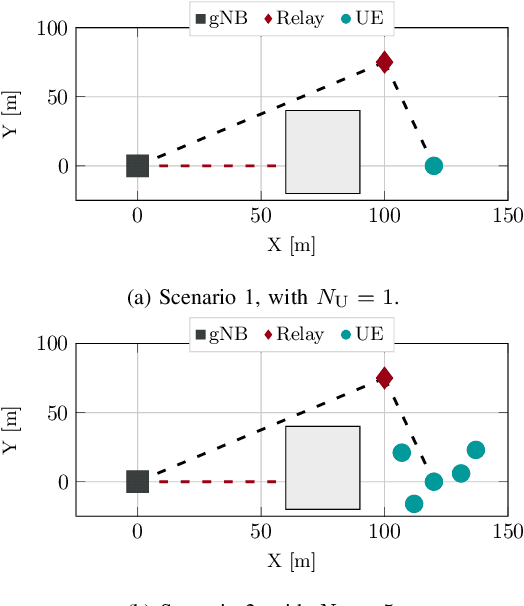

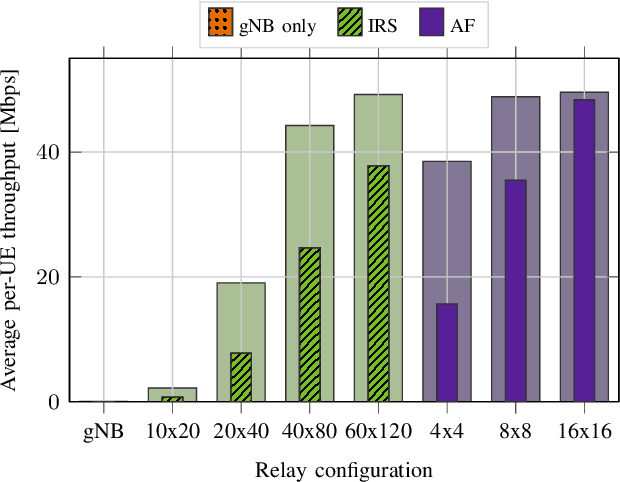
Abstract:The high propagation and penetration loss experienced at millimeter wave (mmWave) frequencies requires ultra-dense deployments of 5th generation (5G) base stations, which may be infeasible and costly for network operators. Integrated Access and Backhaul (IAB) has been proposed to partially address this issue, even though raising concerns in terms of power consumption and scalability. Recently, the research community has been investigating Intelligent Reflective Surfaces (IRSs) and Amplify-and-Forward (AF) relays as more energy-efficient alternatives to solve coverage issues in 5G scenarios. Along these lines, this paper relies on a new simulation framework, based on ns-3, to simulate IRS/AF systems with a full-stack, end-to-end perspective, with considerations on to the impact of the channel model and the protocol stack of 5G NR networks. Our goal is to demonstrate whether these technologies can be used to relay 5G traffic requests and, if so, how to dimension IRS/AF nodes as a function of the number of end users.
Can 5G NR-Light Operate at Millimeter Waves? Design Guidelines for Mid-Market IoT Use Cases
Sep 30, 2021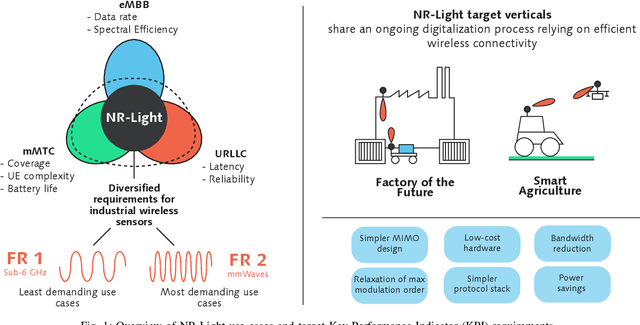
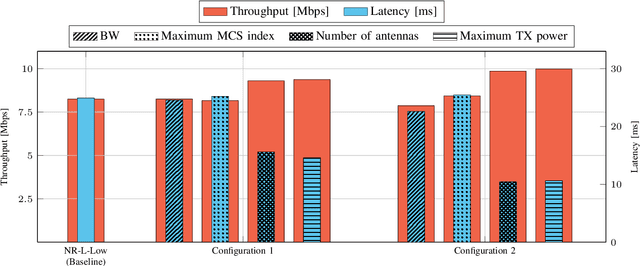
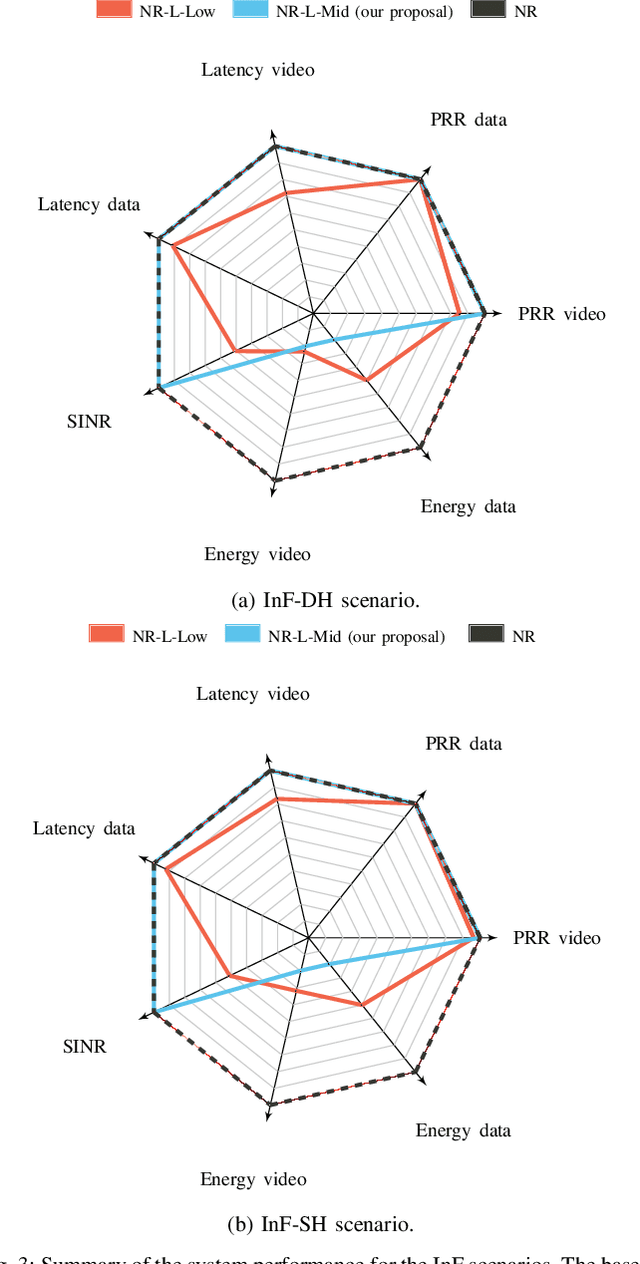
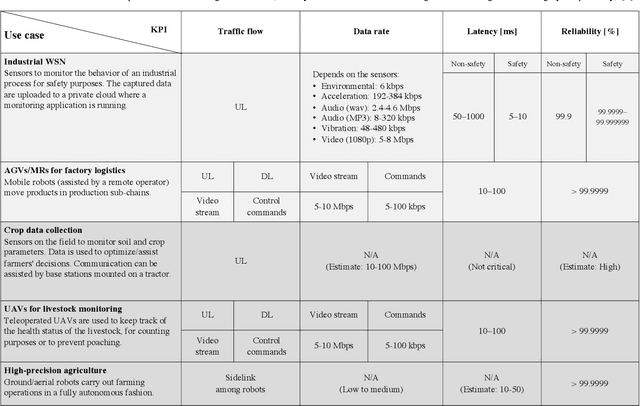
Abstract:5th generation (5G) systems have been designed with three main objectives in mind: increasing throughput, reducing latency, and enabling reliable communications. To meet these (often conflicting) constraints, in 2019 the 3GPP released a set of specifications for 5G NR, one of the main innovations being the support for communications in the millimeter wave (mmWave) bands. However, how to implement lower complexity, energy efficient, mid-market Internet of Things (IoT) applications is still an on-going investigation, currently led by the 3GPP which is extending the NR standard with NR-Light specifications to support devices with reduced capabilities (REDCAP). In this paper we investigate the feasibility of operating such devices at mmWaves, in view of the requirements and expectations for NR- Light applications in terms of cost and complexity, throughput, and latency. Contributions of this paper are threefold. First, we il- lustrate the potential of mmWave communication for mid-market IoT use cases. Then, we highlight and motivate the design of an NR-Light candidate interface derived from NR by a selection of features. Finally, we demonstrate the technical soundness of this interface in an industrial IoT setup via simulations.
 Add to Chrome
Add to Chrome Add to Firefox
Add to Firefox Add to Edge
Add to Edge